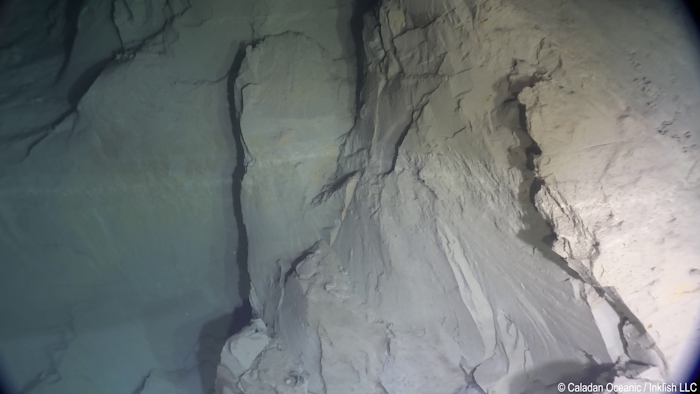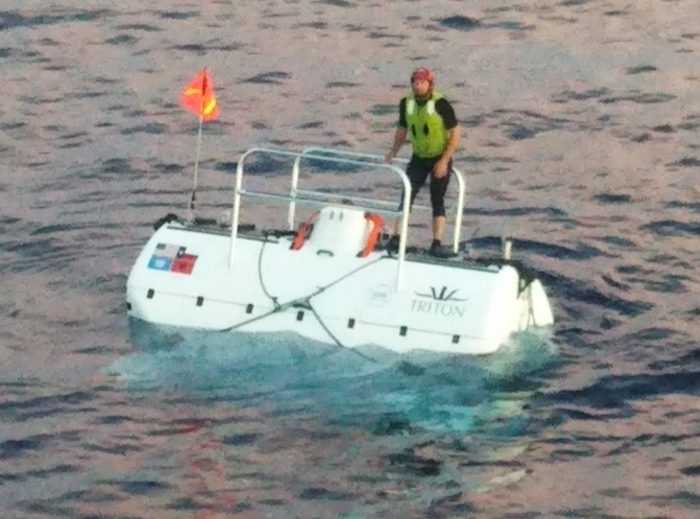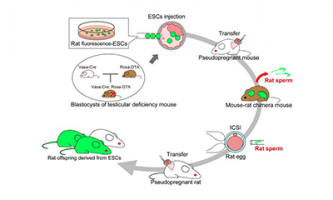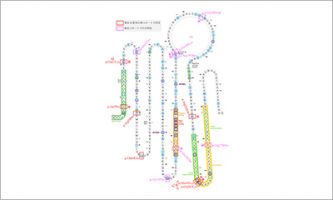A manned submersible found a fault scarp of the 2011 Tohoku-oki megaquake in the Japan Trench
Jan 16 2024
On September 4, 2022, a geologist Hayato Ueda in Niigata University boarded a submarine vehicle with a pilot Chris May and had a dive into the Japan Trench within the epicenter area of the 2011 Tohoku-oki megaquake, which caused the devastating tsunami disaster. On the 7,500 m deep trench bottom, they found a 26 m high nearly vertical cliff on the eastern slope of a 60 m high ridge. Previous bathymetric surveys from the sea surface have revealed that the ridge did not exist before, and appeared just after the megaquake accompanied with a fault on its eastern flank. He and his colleague scientists on deck thus concluded that the cliff was a surface expression of a coseismic movement of the fault. The cliff consisted of unconsolidated soft mud. The lower slope than the cliff was occupied by abundant debris of the same soft mud blocks, which obviously supplied from the cliff. The observed sharp fracture surfaces and highly angular edges, both on the cliff and debris blocks, imply very quick increase of stress that fractured the soft muds before they plastically flowed, and thus support a coseismic origin of the cliff.
The vehicle traversed the ridge across the fault precisely measuring the topography using acoustic transponder and pressure gauge. The height and uplifted volume of the ridge both suggest a coseismic slip of the fault as large as 80–120 m (the value depends on the assumed dip angle of the underlying fault) in the Japan Trench. This estimation is greater than the previously estimated fault slip (~65 m) beneath the slope on the west of the trench axis. They attributed the excess fault slip in the trench to local enhancement owing to the uneven top surface of the subducting Pacific plate, which modified the fault geometry and stability.
The 2011 megaquake resulted from rupture and slip of the plate boundary fault between the northeast Honshu Island of Japan (Okhotsk plate) and the subducting Pacific plate. After the earthquake, many geodetic and geophysical studies have proposed that this coseismic fault movement probably propagated to the trench. Because topographic change by near-surface fault movement is one of the major causes of tsunamis, it is important to precisely know what occurred in the deep-sea trench when the trench-type earthquake such as the 2011 event occurred. However, because of great depths, no submersible vehicles (neither manned nor remotely operated) had been able to access to the Japan Trench bottom. This study was the first time to observe, visually record, and precisely measure the topographic change (including fault cliff) in the trench by a single trench-type megaquake event. It verified that the fault slip surely propagated to the surface at the 2011 event, and deduced that the amount of the slip was at least locally as great as 100 m. These results are expected to contribute to our understanding of genesis and to hazards of tsunamis triggered by trench-type earthquakes. This study was published by the journal communications earth & environment on Dec. 26, 2023.

Submarine fault scarp captured by the submersible video camera

The submersible “DSV Limiting Factor” used for the survey.
Publication Details
Journal: Communications Earth & Environment
Title: The submarine fault scarp of the 2011 Tohoku-oki Earthquake in the Japan Trench
Authors: Hayato Ueda, Hiroshi Kitazato, Alan Jamieson, Pressure Drop Ring of Fire Expedition 2022 Japan Cruise Leg2 science team
DOI: 10.1038/s43247-023-01118-4
News release
The article was released in EurekAlert, the online publication of the American Association for the Advancement of Science.
More News
-
 Jul 07 2025 Research results
Jul 07 2025 Research resultsFertilizable rat sperm produced in a mouse body by blastocyst complementation
-
 Jun 26 2025 Research results
Jun 26 2025 Research resultsEstimating Microbial Biomass from Air-Dried Soils: A Safer, Scalable Approach ーRevolutionary Technique Estimates Soil Microbial Biomass Using Water-Extractable Organic Matterー
-
 Jun 03 2025 Research results
Jun 03 2025 Research resultsAssociation of rare APOE missense variants with Alzheimer's disease in the Japanese population
